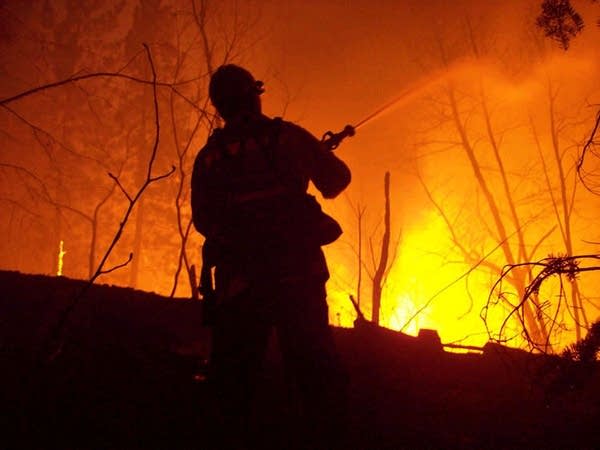Minnesota has had its fill of disasters in 2007
Go Deeper.
Create an account or log in to save stories.
Like this?
Thanks for liking this story! We have added it to a list of your favorite stories.

(AP) - From its northern tip to its southern border, Minnesota is getting roughed up in 2007.
The state has seen fire, floods and a fallen bridge.
"It has been one thing after another," said Judson Freed, past president of the Association of Minnesota Emergency Managers. "This last few months have been really devastating."

Emergency responders insist they're equipped to handle the crises, but with each blow the calls for a special legislative session to speed recovery assistance are increasing.
Turn Up Your Support
MPR News helps you turn down the noise and build shared understanding. Turn up your support for this public resource and keep trusted journalism accessible to all.
In March, rapidly melting snow and ice jams caused the Little Minnesota River to overflow its banks along the western border, damaging more than 140 structures. In that case, lawmakers rushed aid to the community of Browns Valley before adjourning this spring.
In May, a wildfire roared through 118 square miles in northeastern Minnesota and Ontario, Canada. More than 130 buildings were destroyed, but no one was seriously hurt.
The disasters in August have been the cruelest.
The collapse of the Interstate 35W bridge over the Mississippi River killed 13 people, injured many more and left the state's biggest city without a critical artery.

The unrelenting weekend rains across southern Minnesota claimed at least six lives, washed out roads and forced whole communities to evacuate.
Minnesota has experience dealing with multiple emergencies. A decade ago, all 87 counties were under disaster declarations for flooding and related problems, said Kris Eide, who manages emergency services at the Department of Public Safety.
"That's about as much as we can stretch," Eide said, adding that state authorities could turn to other states for help if they were stretched too thin.
But the range of this year's emergencies has spread the workload among responders, from collapsed structures teams that helped with the bridge tragedy to federal firefighters who battled the Gunflint Trail wildfire. Local officials are quick to offer help to their counterparts when they need it, Eide said.
Freed, who directs Ramsey County's Division of Emergency Management and Homeland Security, said only about 30 of the state's counties have full-time emergency managers. The rest leave those duties to sheriffs or fire officials.

"We've been pretty much running full tilt," he said.
The wide reach of the cumulative disasters could help those seeking a special session because more lawmakers now have a stake in one.
"We sure do have the demand, and we sure do have the problems," said Sen. Dick Day, R-Owatonna. He added, "If there has ever been a time that the state has needed to have everyone work very hard together, it's right now. The partisanship stuff will go out the window pretty fast - hopefully."
Gov. Tim Pawlenty, a Republican, has sole power to summon lawmakers back to St. Paul before their next session, which is scheduled to begin Feb. 12.
"It has been one thing after another."
However, the DFL-led Legislature decides on its own when to adjourn a special session. Pawlenty wants a prior agreement on the scope of their work, in part to head off bills he opposes.
Sen. Tom Bakk, DFL-Cook, worries that the window of opportunity will slip away if such an agreement isn't struck soon.
"As time continues to pass and we move closer and closer to February, the interest probably subsides," Bakk said.
House Minority Leader Marty Seifert, R-Marshall, said lawmakers need to know what the immediate needs are and whether existing dollars can cover them before returning to the Capitol.
As the disaster toll builds, he suspects the anxiousness for an emergency session will too.
"There's going to be a perception that one is needed, whether one is or isn't," Seifert said. "In politics, perception is reality."
(Copyright 2007 by The Associated Press. All Rights Reserved.)




